On This Page
Can Birds Improve Your Mental Health?
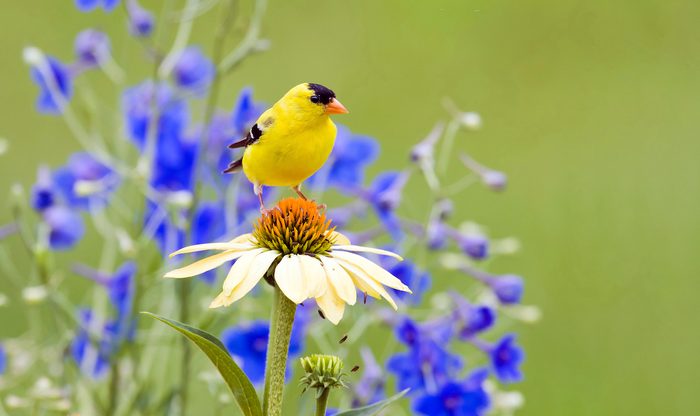
Cardinals, chickadees, juncos, woodpeckers … action! My feeders are full of life. I’ve been feeding birds since I was a little kid. But I only recently reflected on why I have kept feeding them for so many years.
Birds can find food on their own. I know their survival doesn’t depend on me, although I do hope my bird feeders help them in hard times. Personally, feeding birds makes my life better. Watching them right outside my window brings me reliable peace and joy. And there is research that shows watching birds boosts mental health.
Discover the mental and physical health benefits of gardening.
Finding Joy in Feeding Birds
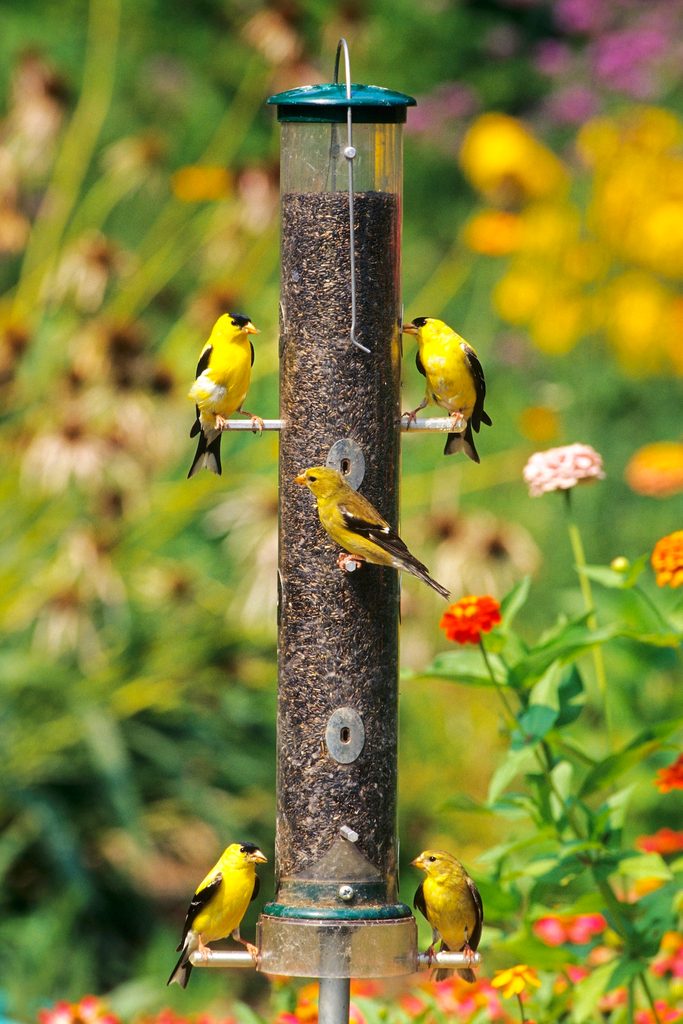
It’s such a simple way to improve my mental well-being. And it’s not just me. Feeding birds as a pastime exploded in popularity during the COVID-19 pandemic. A recent Audubon article described a measurable boom in birdseed sales that began then and continues today—evidence that bird feeding fulfills our human need for connection.
I was delighted to see that the Cornell Lab of Ornithology’s Project FeederWatch collects data on these benefits. Their current data entry portal includes two places for observers to rank the emotional states they experience while conducting monthly feeder surveys. I had no hesitation in giving my bird survey the happiest ranking available!
My friend, Alanna, posted a picture of her brand-new but still empty feeders on Facebook. She was worried because birds were not visiting them. I commented on the post, sharing perspective on being patient while her neighborhood birds discover her offerings. I then followed up with an email asking if she could tell me why she decided to start feeding at the start of 2024.
She responded: “As someone who struggles with anxiety, it can be almost debilitating to think about getting out of the house in pursuit of birding opportunities. Having an at-home bird feeder alleviates that anxiety.” I told her I also find observing birds boosts mental health.
The Healing Power of Nature
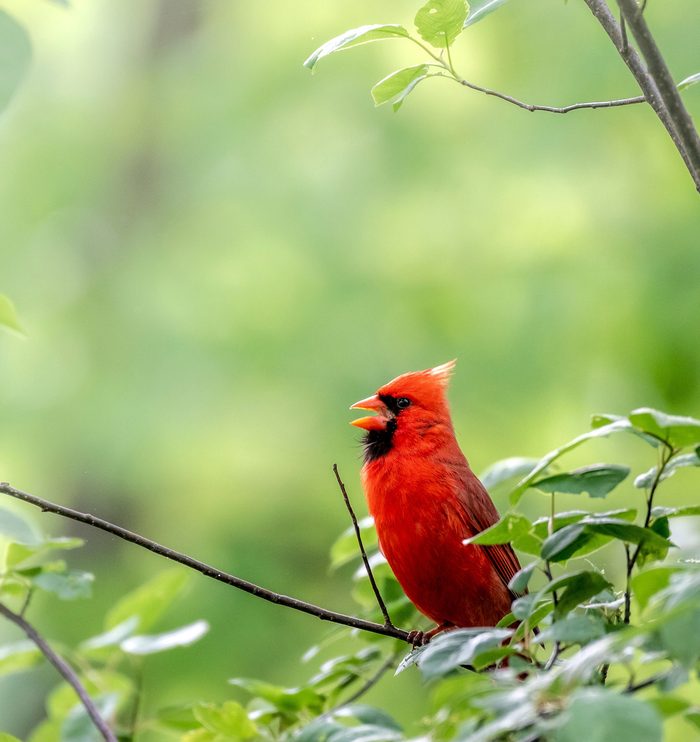
The number of books touting the positive effects of exposure to nature on mental health increases yearly. A quick search nets a flock of popular titles that reflect the underlying surge in academic studies combining interdisciplinary research from fields as far-flung as ecology, theology, psychology, medical science, urban planning, gardening and landscape architecture—well, the connections are seemingly endless.
But why is nature so healing? Two psychology professors at the University of Michigan, Rachel and Stephen Kaplan, found an answer through their research on two types of attention: directed attention and fascination. Because we spend much of our time in directed attention, focused on doing and thinking, they found this results in directed energy fatigue. And spending time in nature, a form of fascination, allows people to reset from task-driven fatigue.
If you see a cardinal, here’s what it means.
Building Resilience
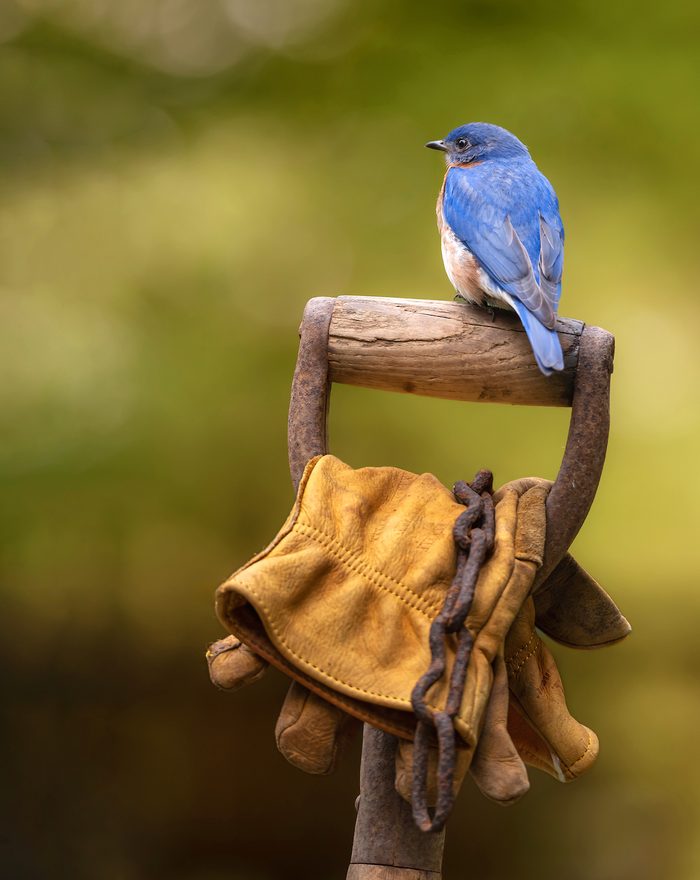
Following this same thread, Terry Hartig, a professor in the psychology department of Uppsala University in Sweden, conducted research on “restorative environments.” In particular, his research focused on how contact with nature can help build resilience in several areas of modern life.
Licensed therapist Tammah Watts first experienced the healing properties of bird-watching in the face of chronic pain. Eager to share her discoveries, she penned a how-to guide called Keep Looking Up, full of tips for connecting birds with mental and spiritual well-being.
And in one recent study, researchers directed more than 1,200 participants to use a smartphone app called Urban Mind to collect data on how they felt after hearing or seeing birds. Encouragingly, the results concluded that observing birds had positive effects on people with and without depression.
So it seems like the link between watching birds and mental health is not just wishful thinking—it’s a researched and documented subject of many scientific studies. More simply, think of watching your feeders as a little spa for your mind and spirit— and it’s one with unlimited visits.
Here’s to your mental health, and the well-being of your feeder birds!
Restorative Reflections
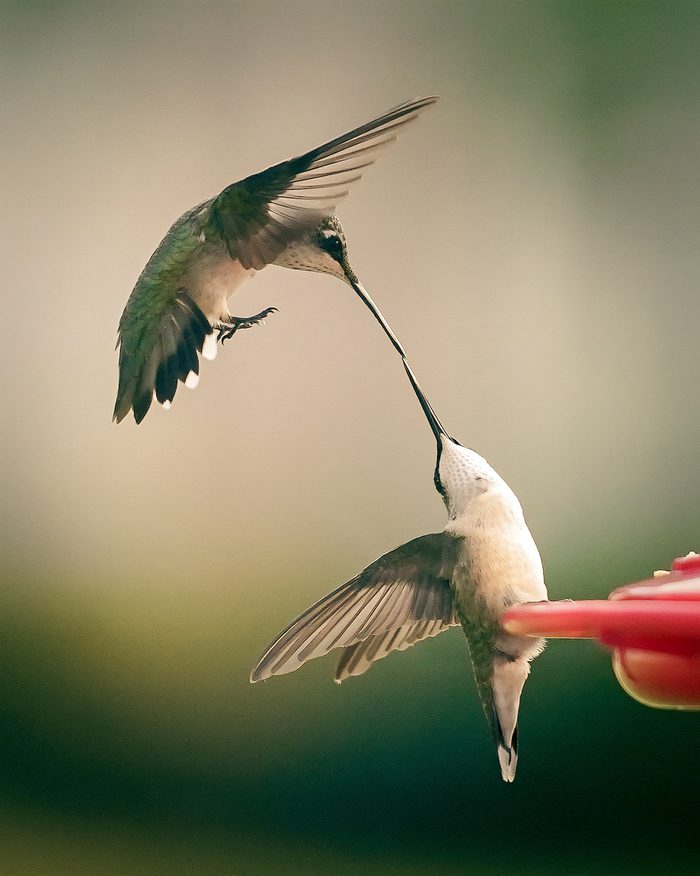
Here are four different ways I experience mental restoration with feeder-watching. This list may give you some ideas for your own experience.
- Birds pull me out of my worries and self-absorption. Looking at birds, even for an instant, I find respite from everyday worries and planning. I’m living in a restorative frame of mind when I revel in the brilliant scarlet of a cardinal.
- Birds mark the seasons. I look forward to a purple finch arriving from the North as much as I anticipate American goldfinches changing from drab beige to brilliant yellow in early spring. My feeder birds remind me of the resilience of life.
- Birds bring unexpected drama. Anticipation and excitement are therapeutic to me. A sharp-shinned hawk swoops in to study nearby birds, and I am caught up in the tension of the chase.
- Birds are poetry in motion: graceful movement, a palette of color, shapes, patterns and behaviors. The poet Emily Dickinson once wrote “Hope is the thing with feathers,” and it’s still true today.
Sources
- CHAAD – Spend Time Outside to Improve ADHD Symptoms
- American Psychological Association – Green Is Good for You
- Uppsala University – Nature-based biopsychosocial resilience
- Springer Nature – Restoration in Nature: Beyond the Conventional Narrative
- National Audubon Association
- Cornell Lab of Ornithology – Project FeederWatch
- Scientific Reports – Smartphone-based ecological momentary assessment reveals mental health benefits of birdlife
- Science Advances – Linking the nonmaterial dimensions of human-nature relations and human well-being through cultural ecosystem services
Why Trust Us
For nearly 30 years, Birds & Blooms, a Trusted Media Brand, has been inspiring readers to have a lifelong love of birding, gardening and nature. We are the #1 bird and garden magazine in North America and a trusted online resource for over 15 million outdoor enthusiasts annually. Our library of thousands of informative articles and how-tos has been written by trusted journalists and fact-checked by bird and garden experts for accuracy. In addition to our staff of experienced gardeners and bird-watchers, we hire individuals who have years of education and hands-on experience with birding, bird feeding, gardening, butterflies, bugs and more. Learn more about Birds & Blooms, our field editor program, and our submission guidelines.
On This Page
What Do Northern Saw-Whet Owls Look Like?
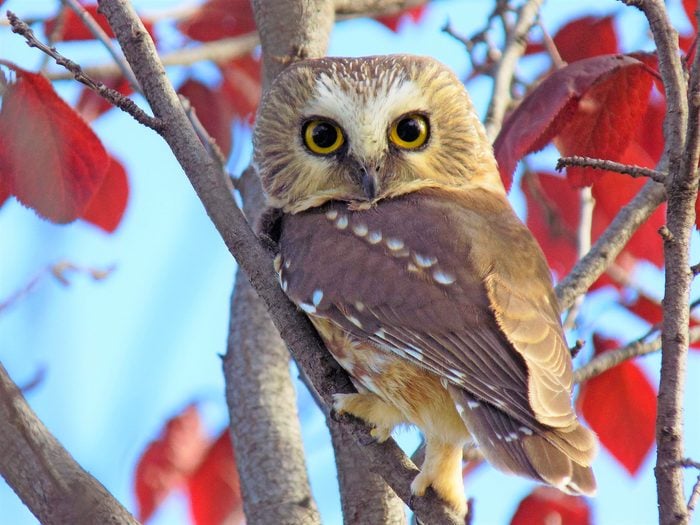
One of the cutest birds ever, (as voted on by Birds & Blooms readers) is the northern saw-whet owl, and Phil Brown, Bird Conservation Director at the Harris Center for Conservation Education in Hancock, New Hampshire, agrees. “They are one of the most charismatic species,” he says.
The micro sized owls stand around 8 inches tall, roughly the size of a robin. According to Phil, “saw-whets weigh about the same as a stick of butter.”
Although they are fairly common, saw-whets are highly nocturnal and rarely seen.
Round faces with oversized endearing yellow eyes add to their charm. Both males and females look the same with mottled brown plumage. Females are larger than males, but this is difficult to discern from field observations. Instead, biologists assess this with weights and wing measurements.
Age is another characteristic that researchers can determine. Phil says at owl banding stations, researchers shine blacklights on the wing feathers. Younger saw-whet owls shine pink due to higher amount of a chemical on the feathers that breaks down in sunlight. Older birds retain less of this porphyrin, so they are duller under the blacklights.
Discover the amazing types of owls in North America.
Range and Habitat
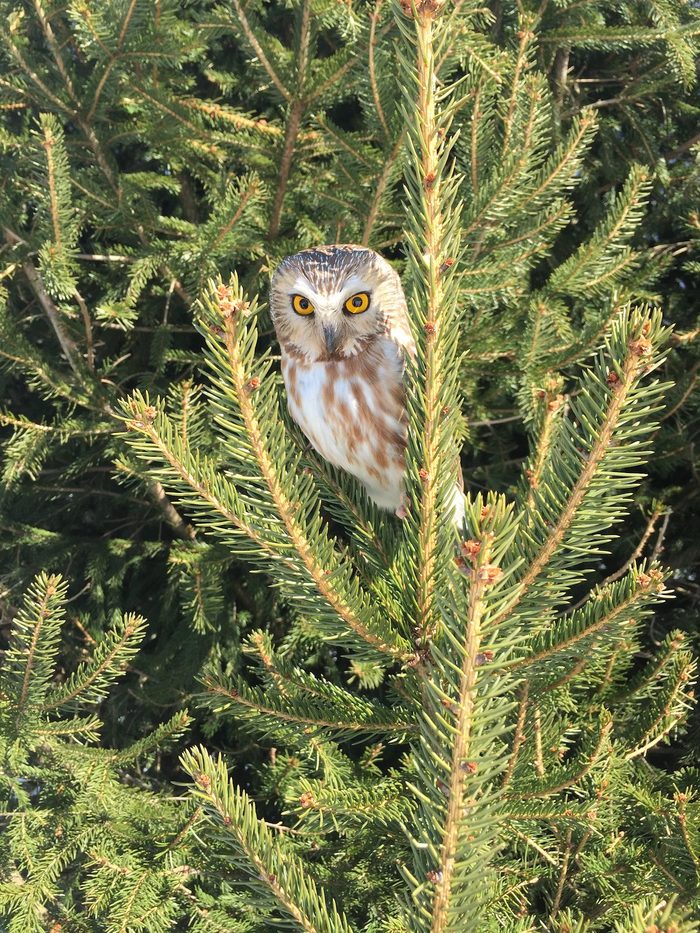
Northern saw-whet owls breed in the forests of Canada, and in the western mountains south through central Mexico. They also breed in the northeastern states and locally in the higher elevations of the Appalachians. In fall, saw-whet owls spread out from their breeding grounds. Winter range includes much of the Great Lakes, New England and parts of the Midwest. Southern states also see winter arrivals of saw-whets, but in more limited numbers.
Phil explains that “saw-whets have feathers all the way to their toes, an adaption for cold weather survival.”
A key to winter habitat is “dense thickets of conifer trees,” says Phil. Project Owlnet banding efforts like those at the Harris Center have helped researchers determine that not every owl migrates each winter.
The alarm notes of songbirds may draw your attention to a roosting saw-whet owl in dense conifer stands. The nocturnal owl is famously tame if approached, but if you come across one you should give it plenty of space as to not disturb the bird or reveal its location opening it up to harassment from other birds.
You might also see the elusive birds at a banding program as researchers continue to learn more about distribution patterns.
The National Audubon Society Climate Report predicts a 99% loss of current winter range by 2080. Northern saw-whets could be gone from the lower 48 states by the end of the 21st century.
Eastern vs western screech-owl: what’s the difference?
Nesting Habits
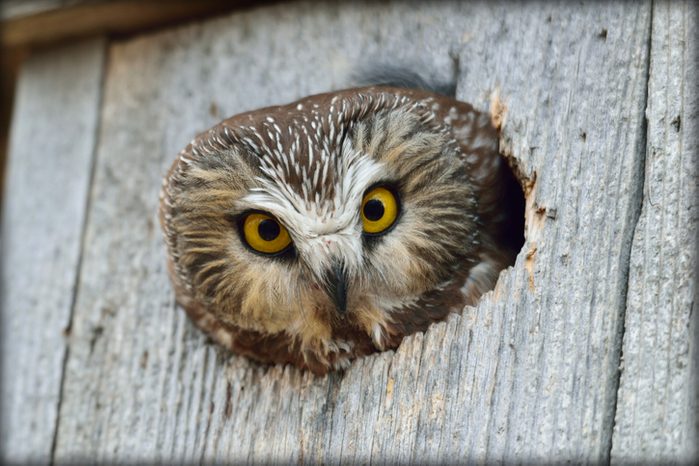
During courtship, female saw-whets will respond to the classic “too-too-too” call of males with a “tssst” call or repeated whistles. Males then circle the potential mate multiple times before perching nearby and presenting her with a prey item offering.
Northern saw-whet owls rely on cavities for nesting. “They are secondary cavity nesters,” say Phil, “so they rely on old woodpecker holes.” The species will use nest boxes when placed in appropriate mixed forest habitat, although they don’t generally return to the same cavity for nesting year after year.
Saw-whets tend to lay eggs on the existing debris in chosen cavities without building an entirely new nest. Females lay 4 to 7 smooth white eggs and incubate for nearly a month. Male saw-whets provide almost all of the food supply while the female owls incubate eggs and brood the young birds.
Learn how to attract owls to nest in your backyard.
Diet: What Do Northern Saw-Whet Owls Eat?
Despite their pint size, saw-whets are equipped with the same tools as the larger owls. “They have tiny, hooked raptor bills and sharp talons for killing,” says Phil.
Northern saw-whet owls will eat a variety of flying things including insects, bats, and songbirds, but their main food source is rodents. “They are small mammal generalists,” says Phil.
Every 4 years or so, as small mammal populations surge, saw-whets have a population boost as many young birds survive. These years also show a strong migration push, says Phil.
Larger prey items will be split up into multiple meals. The leftovers are sometimes stashed in tree cavity cupboards.
As with other raptors, rodenticides are a concern for saw-whet owls. The toxins accumulate in the owls if they eat rodents that have been exposed to the poisons.
Did you know: the elf owl is the smallest owl in the world.
Call and Sound
Bird sounds courtesy of the Cornell Lab of Ornithology
Despite being named after the sound of sharpening blades on whetstones, the tiny northern saw-whet owl’s charming, toot-toot calls are hardly menacing.
“They sound like the high-pitched beeps as a truck is backing up,” say Phil. He continues, that saw-whet owls make a variety of other noises including “high pitched squeaks, squawks, and whistles that are often confused with flying squirrel noises.”
Do owl sightings have special meaning?
About the Expert
Phil Brown (he/him) spent his childhood in Staten Island, New York, where he was fascinated with the natural world, especially the birds that passed through his suburban backyard. After undergraduate studies at Rutgers University, he pursued a career in natural resource management. Currently he serves as the Bird Conservation Director for the Harris Center for Conservation Education in Hancock, New Hampshire.
Sources
- National Audubon Society
- Cornell Lab of Ornithology
On This Page
What Does a Wood Thrush Look Like?
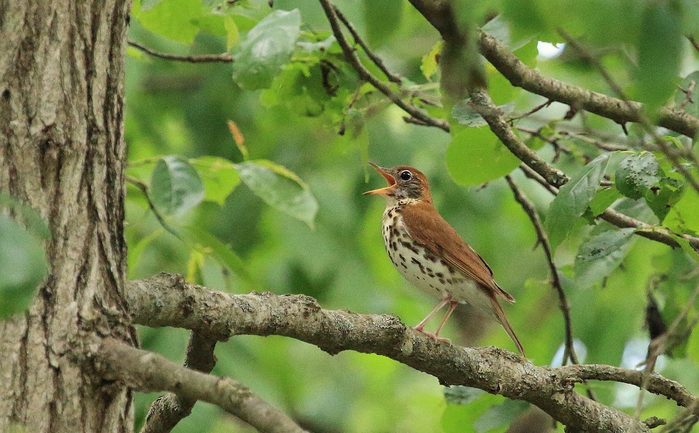
There are very few birds with songs that can rival the dreamy notes and complex trills of the wood thrush. These forest-dwelling birds can be hard to spot. Their field markings give them great camouflage that allows them to blend in with their surroundings.
“Most often you’ll hear them and not see them,” says Zach Ladin, an ecologist for U.S. Fish and Wildlife Service. Thrush species, including wood thrush, are known for their dreamy, flute-like song and complex trills. “For this reason, identifying wood thrushes by their song is a great method,” Zach says.
But if you are on the search, it’s easiest to spot them on the ground. Wood thrushes are medium-sized birds and larger than other thrush species, like hermit and Swainson’s thrushes. Both male and female wood thrushes have dark, bold spots on their chests and rich, cinnamon coloring on their backs and heads. Their large eyes help them spot bugs in thick, shady forests.
Learn to identify more small brown birds you might see.
Wood Thrush Habitat and Range
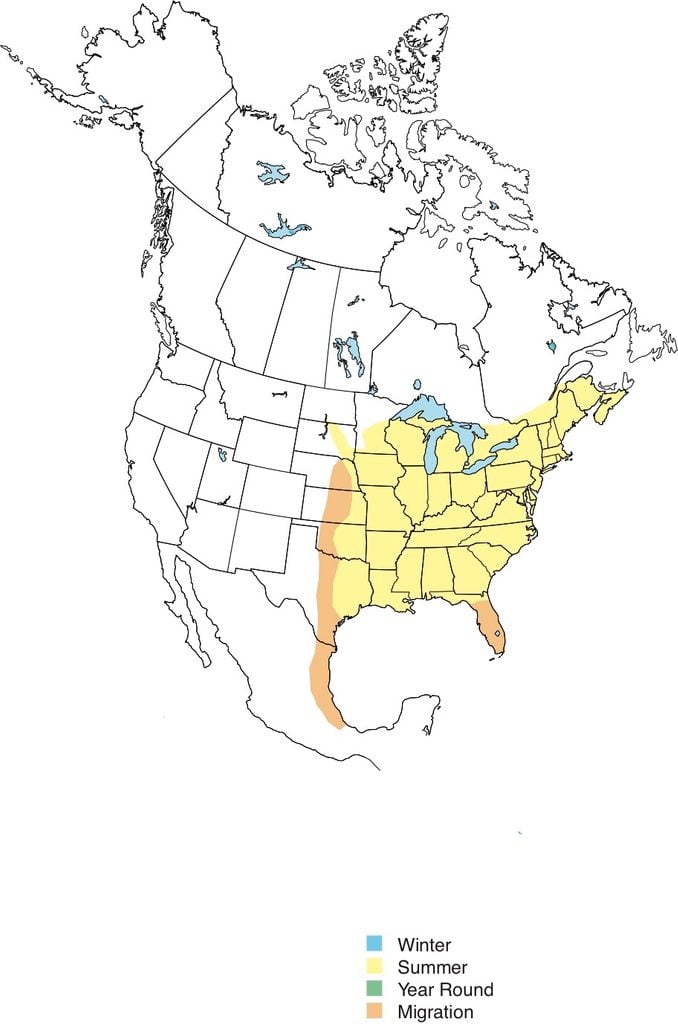
Range maps provided by Kaufman Field Guides, the official field guide of Birds & Blooms.
Wood thrushes live in the Midwest and eastern U.S. and stick to deciduous and mixed forests with dense undergrowth during their breeding season from May to August. When the weather gets colder, they head south to Central America.
Although wood thrushes are considered a common bird, their numbers have been declining since the 1950s due to loss of habitat and forest fragmentation.
“When forest habitat is reduced, there may be less food available and an increase in negative effects from predators and nest parasitism from brown-headed cowbirds,” says Zach. “We must take a holistic approach and work with international partners to protect habitats. We can protect those areas for birds and protect critical ecosystems that support life on Earth for humans — it’s a win-win.”
Learn how to identify a varied thrush.
Nesting Habits
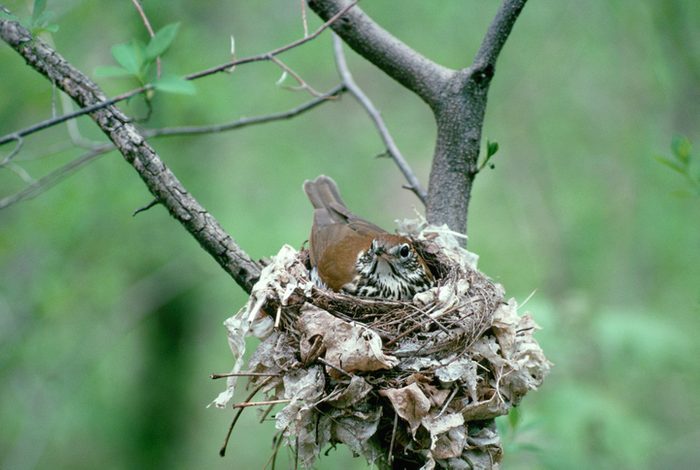
“Wood thrushes tend to build their nests in the forks of branches of understory shrubs or young trees,” says Zach. “On average, nest height is around 13 feet high but can range between two feet and over 90 feet from the ground.” The male finds and establishes the breeding ground. After courtship activities, like mutual feeding, the female selects the nest site.
Their nests are cup-shaped and lined with leaves, grass and, similar to American robins, a layer of mud. Sometimes they incorporate manmade materials, like cellophane and bits of paper, into the nest structure, too. Each nest holds three to four eggs.
A pair of wood thrushes will usually raise two broods per season in two separate nests. (Both parents feed the fledglings at first, and then the male continues feeding them after the female lays her next clutch of eggs.) Although wood thrush pairs raise their young together, they’re not monogamous. It’s relatively common for fledglings in a single brood not to share the same father.
One of the biggest challenges wood thrushes face during breeding season is contending with brown-headed cowbirds. This has been made worse by loss of habitat. “In a long-term study we conducted on wood thrushes in a fragmented landscape in Delaware, we found that despite having plenty of high-quality food, wood thrushes were negatively affected by brown-headed cowbirds, which lay their eggs in wood thrush nests,” Zach says.
Caring for and feeding the young cowbirds takes up the energy and time of the parent wood thrushes often at the fatal expense of their own young.
Diet: What Does a Wood Thrush Eat?
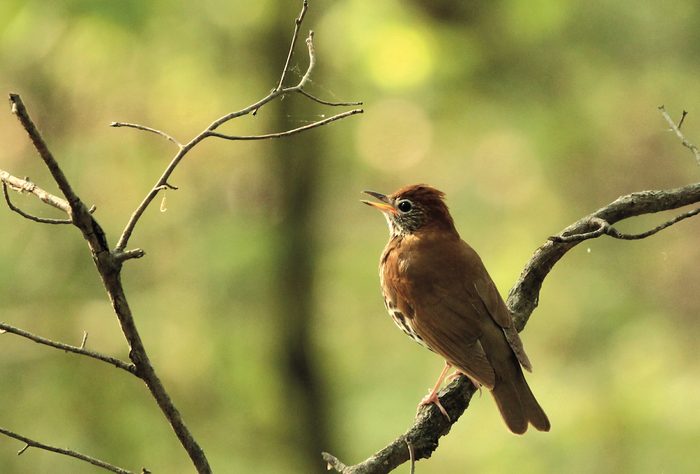
Wood thrushes hop along the forest floor and hunt for insects in the soil and under leaves. “They often forage in the leaf litter for invertebrates including snails and spiders,” says Zach. The shells of snails are an important source of calcium for female wood thrushes during breeding season. Small fruits and berries are also important items on the wood thrush menu, especially in late summer when they are preparing to migrate south.
However, if you’re hoping to attract wood thrushes to your backyard, you’re facing an uphill battle. “Wood thrushes are not your typical backyard bird, because they prefer mature forests with moderate understory vegetation,” says Zach. “But if you live on the edge of a forest or forest patch in the eastern U.S., you may have wood thrushes nearby during the breeding season.”
Wood Thrush Song
Bird sounds courtesy of the Cornell Lab of Ornithology
This species’ recognizable song is usually written out as ee-oh-lay but there’s a lot of complexity behind it. “Wood thrushes belong to a group of related thrush species that are known for having some of the most extraordinary songs in the bird world,” says Zach. “By passing wind through both sides of its vocal organ, called a syrinx, a wood thrush can generate its beautiful song with many overtones to create a rich, harmonic sound.” Essentially, it’s as though the bird is singing a duet with itself.
Because of all the different pitch and note variations available to these birds, a single male may sing up to 50 distinct versions of its song.
About the Expert
Zach Ladin is an ecologist who works in the Division of Migratory Birds in the U.S. Fish and Wildlife Service. He’s passionate about integrating ecological data and novel technologies to inform how humans can promote ecosystem health and function in light of increasing rates of global urbanization and climate change.
Sources
- National Geographic Backyard Guide to the Birds of North America: Jonathan Alderfer and Paul Hess
- All About Birds
- National Audubon Society
- American Bird Conservancy
- Smithsonian’s National Zoo & Conservation Biology Institute
Why Trust Us
For nearly 30 years, Birds & Blooms, a Trusted Media Brand, has been inspiring readers to have a lifelong love of birding, gardening and nature. We are the #1 bird and garden magazine in North America and a trusted online resource for over 15 million outdoor enthusiasts annually. Our library of thousands of informative articles and how-tos has been written by trusted journalists and fact-checked by bird and garden experts for accuracy. In addition to our staff of experienced gardeners and bird-watchers, we hire individuals who have years of education and hands-on experience with birding, bird feeding, gardening, butterflies, bugs and more. Learn more about Birds & Blooms, our field editor program, and our submission guidelines.
On This Page
What Does an American Redstart Look Like?
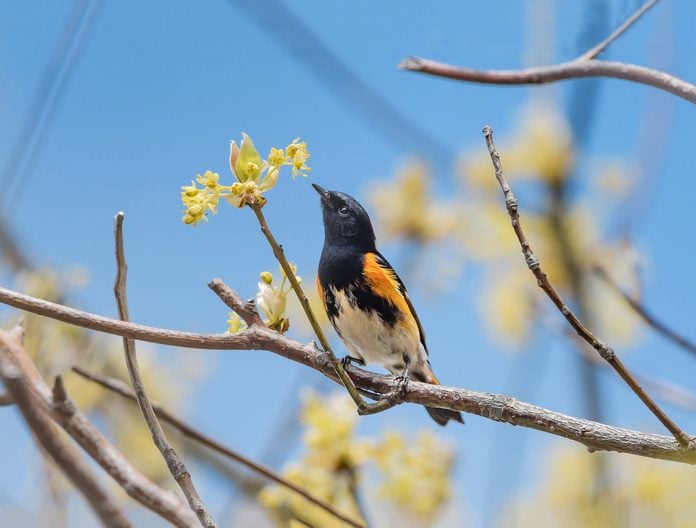
Bright yellow plumage is common among warblers, but the vibrant American redstart is distinctive. Males are mostly black, but bright orange patches on their sides, wings and tails help them stand out from leafy foliage.
“A lot of warblers can be tricky because they resemble other warblers, but there’s nothing like redstarts,” says Bill Rowe, president of St. Louis Audubon Society. “They’re immediately recognizable. The adult males, especially, but the females, too.”
Females have a more muted color scheme—their gray heads and dark wings are less eye-catching than the colors of their mate. Females have a patch of yellow on their sides, and a muddy yellow coloring extends to their tail and wings.
American Redstart Behavior
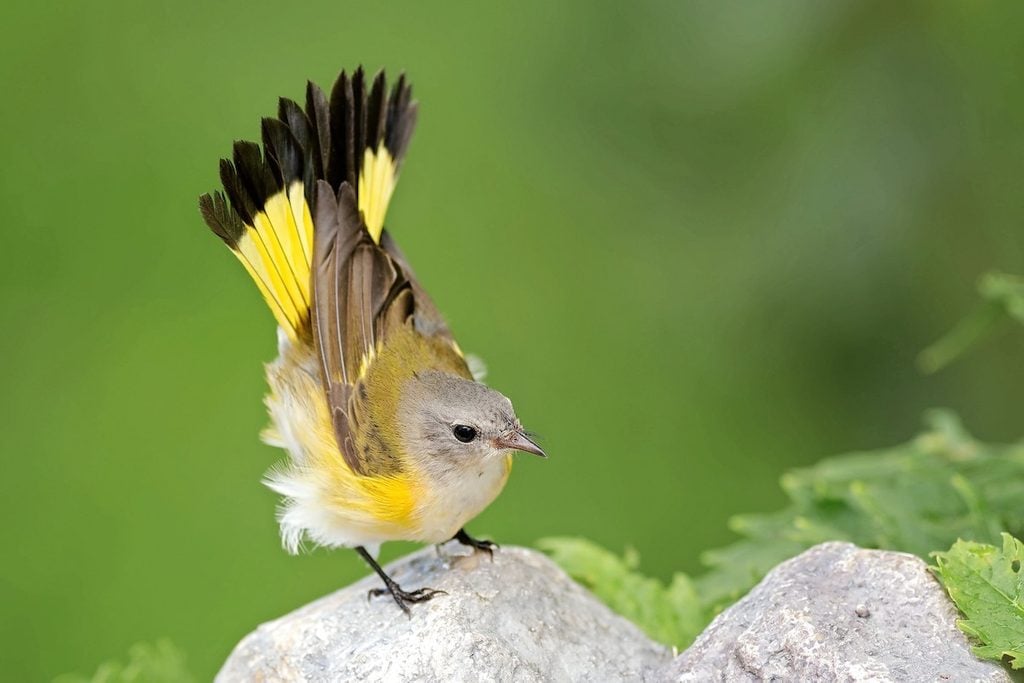
Redstarts are among the most active warblers. As a notable behavioral quirk, they tend to fan out their tails as they move, which makes them easy to identify.
“Theoretically, they do that to flush insects out so they can catch them in flight,” explains Dr. Kevin McGowan, senior course developer for the Cornell Lab of Ornithology’s Bird Academy. “They do a lot of fly-catching, so they’re trying to frighten the insects that are hiding into revealing themselves by flying away.”
Discover more fascinating facts about warblers.
American Redstart Habitat and Range
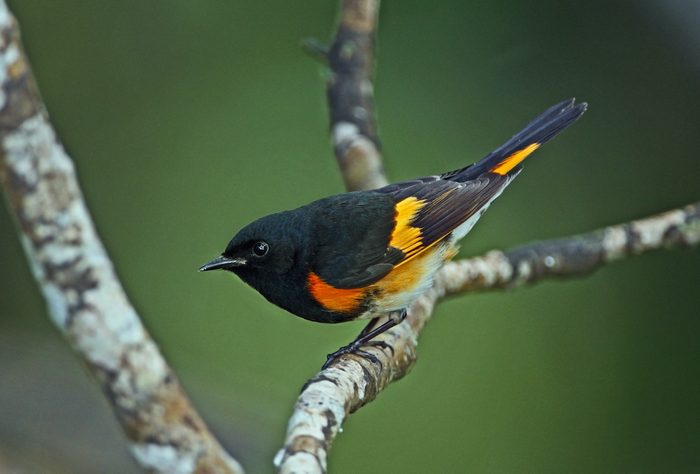
If you’re birding in spring on the edges of eastern forests, be sure to look for redstarts. While they migrate through much of the United States (with the exception of California), they remain for breeding season in the Midwest, Northeast, and a few Southern states such as Alabama and Louisiana.
Redstarts, like many warblers, prefer a forest habitat. In some sections of their range, birders can find them in woods along rivers or even in orchards.
“They’re one of the easiest [warblers] to observe,” says Bill. “Partly because they’re common, but also because many warblers are either high up in the trees most of the time, or they’re hiding in shrubbery. Redstarts like to hang out in somewhat open areas, where they will flit around and hunt for food.”
Learn how to identify yellow-rumped warblers.
American Redstart Diet
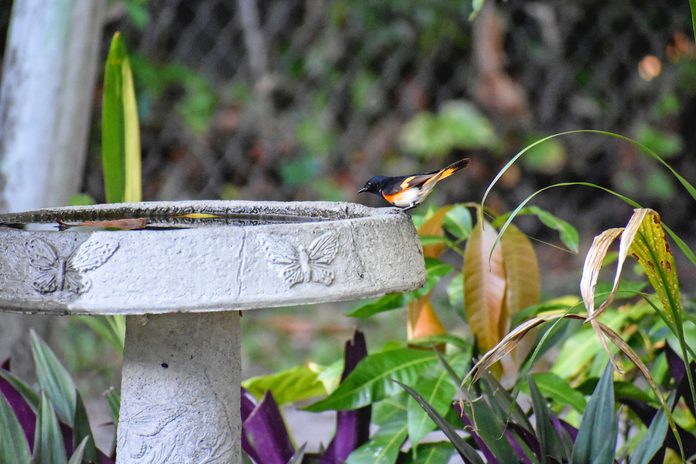
Like most warblers, redstarts usually aren’t interested in bird feeders. Primarily eating bugs, they’re known to dine on flies, moths, beetles, and other insects. They’ll also eat berries from time to time, especially barberry, serviceberry, and magnolia.
Unlike common songbirds, they don’t eat seed—but you might be able to attract warblers into your yard with a bird bath.
Bill says that if you live in the redstart’s migrating range and preferred habitat, all you really need to do is go outside and birdwatch in your yard. “Sooner or later, you’ll see one of the groups of migrants,” he says. “It varies day by day. Watch for movement in the trees.”
Yellow warbler vs goldfinch: learn how to tell the difference.
Nest and Eggs
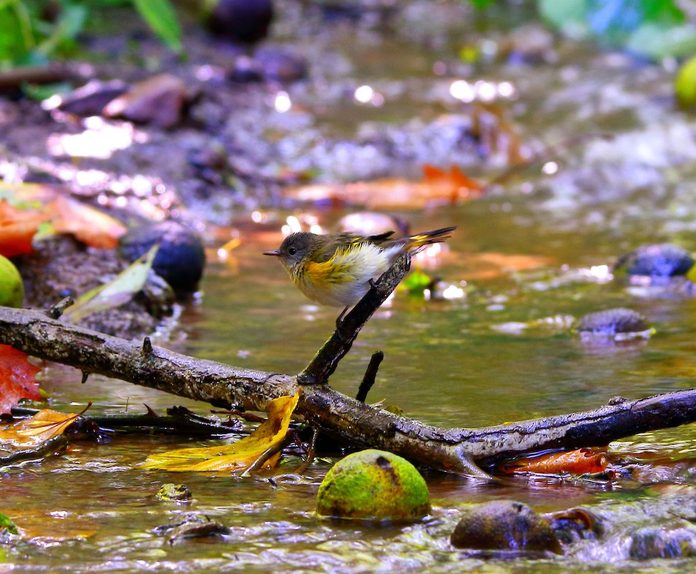
After constructing a nest, a female redstart lays a clutch of one to five eggs. She incubates the eggs for up to two weeks, and young birds remain in the nest for up to two weeks more. The male and female both take part in feeding the fledglings.
“The first-year males look like females,” Kevin says. “When they come back in the spring, they will sing and try to attract a mate, and it looks like a female that’s singing, but it’s actually a male. They get adult plumage the second year.”
Attract a prothonotary warbler with a birdhouse
American Redstart Song
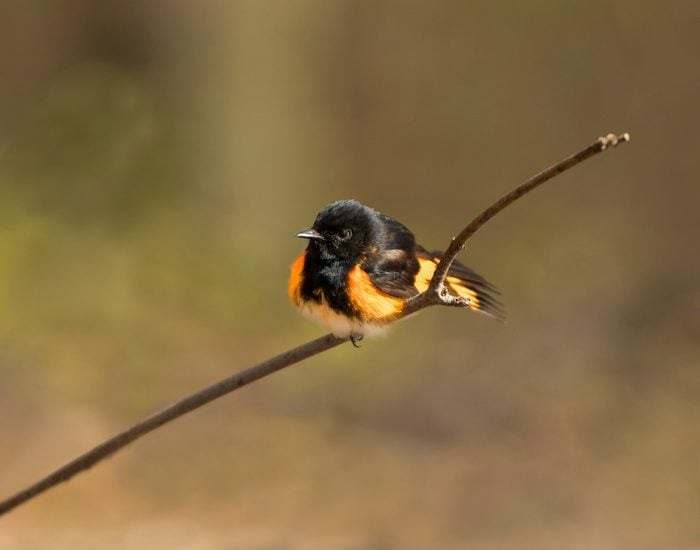
This warbler’s high-pitched, variable song often ends in a sharp shew. Some birders compare the sound to a sneeze.
Bird songs courtesy of the Cornell Lab of Ornithology.
Want to learn more about warblers? Meet the magnolia warbler and black-and-white warbler.
About the Experts
Lifelong birder and ornithologist Dr. Kevin McGowan is a senior course developer for the Cornell Lab of Ornithology’s Bird Academy. He earned a Ph.D in biology at the University of South Florida.
Bill Rowe is the president of St. Louis Audubon Society. Throughout his many years of volunteering and serving on the Board, he has written “Bird of the Week” columns, led field trips and private birding tours, and taught birding classes.
Sources
Why Trust Us
For nearly 30 years, Birds & Blooms, a Trusted Media Brand, has been inspiring readers to have a lifelong love of birding, gardening and nature. We are the #1 bird and garden magazine in North America and a trusted online resource for over 15 million outdoor enthusiasts annually. Our library of thousands of informative articles and how-tos has been written by trusted journalists and fact-checked by bird and garden experts for accuracy. In addition to our staff of experienced gardeners and bird-watchers, we hire individuals who have years of education and hands-on experience with birding, bird feeding, gardening, butterflies, bugs and more. Learn more about Birds & Blooms, our field editor program, and our submission guidelines.
On This Page
Collect Milkweed Seeds From Pods
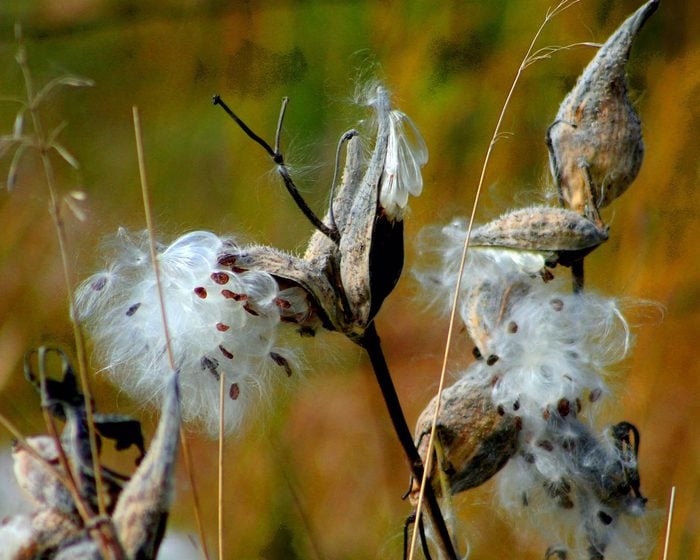
“I collected some dried pods from common milkweed last year. What’s the best way and time to plant the seeds from the milkweed pods?” asks Birds & Blooms reader Judy Roberts.
Horticulture expert Melinda Myers says, It’s hard to believe a plant that readily starts from seed in nature can be challenging for us to do the same. Before planting milkweed, keep in mind that common milkweed quickly forms colonies and can overrun a garden. Others, such as butterfly weed and swamp milkweed, are less aggressive and still support monarch butterflies.”
The seeds must be mature to sprout, so collect seeds just before or as the pods split open after the flowers stop blooming. Melinda says, “Start by removing any seeds remaining in the pods, saving only rich brown seeds that are mature and viable. It’s best to separate seeds from the white fluff, called coma, before drying and storing. You can do this by holding the seeds while in the pod and pulling off the fluff, rubbing the seeds between the palms of your hands or placing them in a paper bag and shaking vigorously.”
You could also consider tying small bags over the milkweed pods while they mature, since many distribute their seeds far and wide (especially common milkweed).
“After the pods on my milkweed plants open, I take the seeds and shake them into envelopes that I’ve labeled with the year the seeds were collected,” says reader Patrick Hogan.
Is tropical milkweed bad for monarchs? Is honeyvine milkweed invasive? Here’s what you need to know.
Milkweed Seed Cold Stratification
You will need to store seeds in the refrigerator or an airtight container in a cold place for several months. This cold treatment is needed to end dormancy and increase sprouting success.
Melinda recommends, “Next, store the dry seeds in an airtight container in the refrigerator until you are ready to process them for planting. Provide seeds with cold, moist stratification to break dormancy right before planting. Place the seeds in a damp paper towel inside a plastic bag, or with sand or vermiculite in a container. Put in the refrigerator for at least 30 days.”
Check out even more of the best types of milkweed to support monarch butterflies.
When to Plant Milkweed Seeds
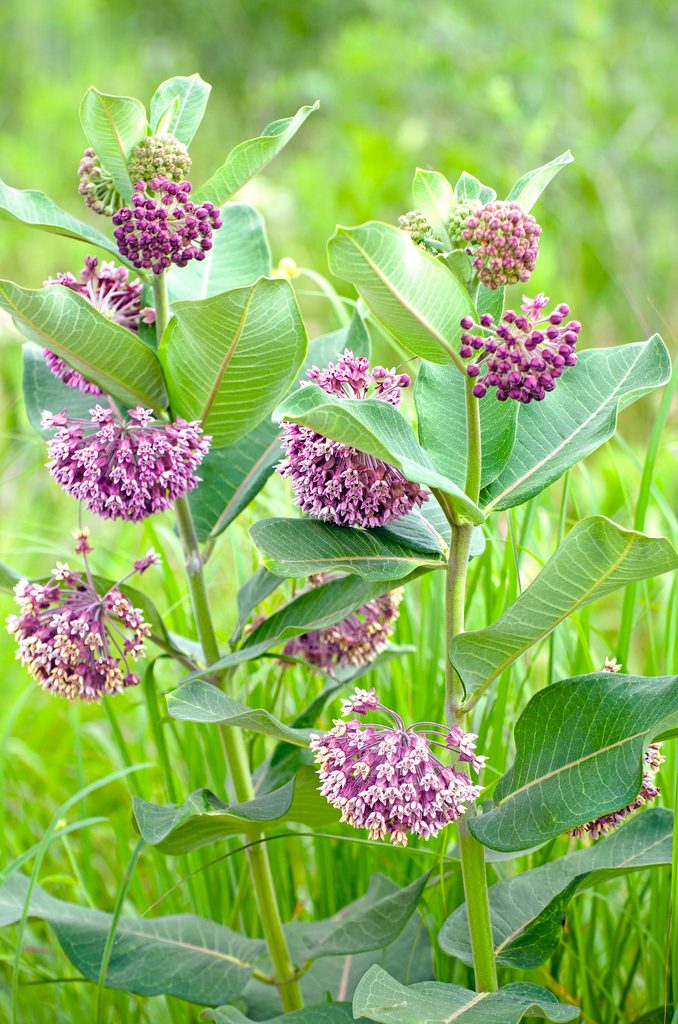
Melinda says, “Once stratified, you can start the seeds indoors or plant them directly in the garden after the last spring frost. Or let nature do the work with winter sowing. Look up instructions online for converting a plastic milk jug into a vessel for starting these and other seeds outdoors. In the future, consider mimicking nature and planting the seeds directly in the garden during fall.”
If it’s possible, start your seeds indoors under artificial lights in a quality potting or seed-starting mix. The seedlings will be ready to transplant in the garden once they are 3 to 6 inches tall and when the threat of the last spring frost has passed. Plan for about four to eight weeks of indoor growing time.
You can also plant seeds directly outdoors. Fall is the best time to direct-sow the seeds for gardeners in cold climates. Many milkweed varieties contain hard coatings that have to break down before the seeds will germinate. Exposure to a winter’s worth of snow and cold, wet weather will do just that.
Check out the Monarch Joint Venture for more information on how to collect seeds from milkweed pods. To order seeds, contact the Live Monarch foundation.
Next, learn how to get rid of aphids on milkweed plants.
About the Expert
Melinda Myers is the official gardening expert for Birds & Blooms. She is a TV/radio host, author and columnist who has written more than 20 gardening books. Melinda earned a master’s degree in horticulture from the University of Wisconsin-Madison.
Sources
- Monarch Joint Venture
- Live Monarch Foundation
Why Trust Us
For nearly 30 years, Birds & Blooms, a Trusted Media Brand, has been inspiring readers to have a lifelong love of birding, gardening and nature. We are the #1 bird and garden magazine in North America and a trusted online resource for over 15 million outdoor enthusiasts annually. Our library of thousands of informative articles and how-tos has been written by trusted journalists and fact-checked by bird and garden experts for accuracy. In addition to our staff of experienced gardeners and bird-watchers, we hire individuals who have years of education and hands-on experience with birding, bird feeding, gardening, butterflies, bugs and more. Learn more about Birds & Blooms, our field editor program, and our submission guidelines.
If you’ve ever visited Hawaii, you’ve no doubt seen and fallen in love with plumeria (Plumeria rubra). The waxy blooms of this plant are the quintessential flower for making traditional Hawaiian leis, and the sweet scent is synonymous with the tropics. But plumeria (also called frangipani) is actually fairly easy to grow just about anywhere, as long you follow a few guidelines.
Discover the top 10 tropical plants for your garden.
On This Page
What Do Plumeria Flowers Look Like?
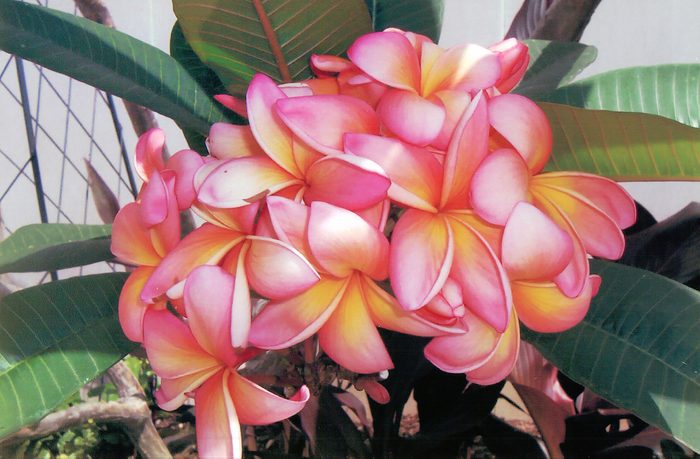
“I took this picture (above) while on vacation in Washington, D.C., outside the National Museum of American History. Do you know what kind of flower it is?” asks Birds & Blooms reader Mark Marino.
Horticulture expert Melinda Myers says, “This beautiful plant is a plumeria that is native to tropical America and has naturalized in Asia and the Pacific Islands. Visitors to Hawaii and other Pacific islands may recognize these flowers that are used to make leis.
Plumeria Care and Growing Tips
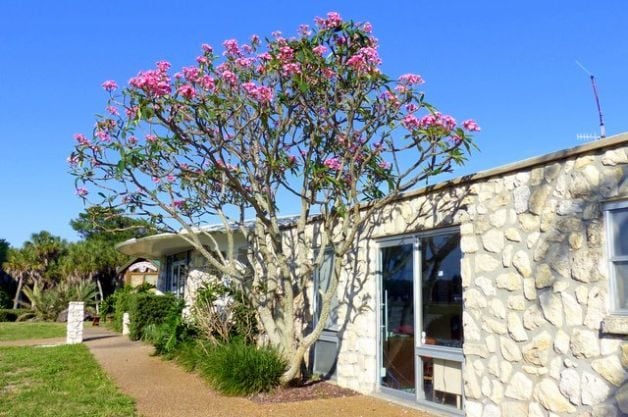
In warmer climates, you can grow plumeria outdoors year-round. If protected from frost and it will become a shrub or even a small tree (as shown above in Tampa, Florida).
“In mild climates, plumeria can grow as tall as 30 feet. In other areas it is grown in containers and moved indoors for winter. This plant needs bright sunlight; warm temperatures; moist, well-draining soil and frequent fertilization when actively growing. The fragrant flowers appear from early summer to fall,” Melinda says.
How to Grow Plumeria From Cuttings
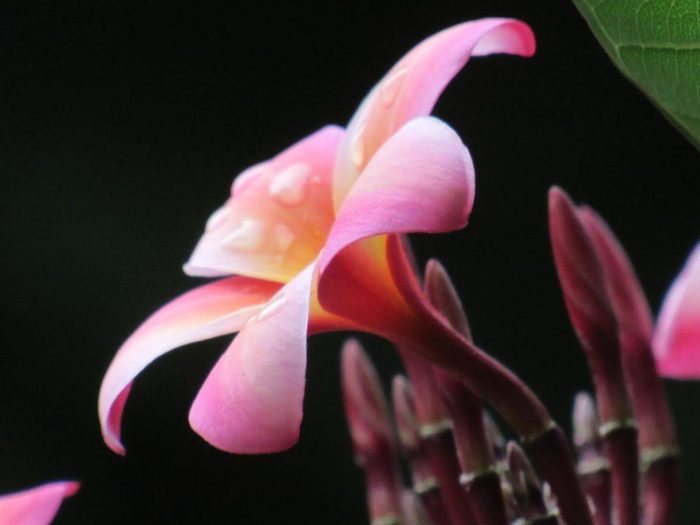
Plumeria is best grown from cuttings from a healthy plant. You can find many places to buy them online. When you order them, you will usually just receive what looks like a thick stick, without much to show for itself.
They are extremely easy to root, though. Just stick them in the soil and give them water and sun. New leaves will begin to grow within a few weeks. Plumeria produces clusters of long-lasting, sweet-smelling flowers from spring through fall, going dormant in the winter.
“My mother purchased this Hawaiian plumeria (above) from a shopping network several years ago. We affectionately referred to it as the ‘stick’ since there were no blooms for the first two years. Since neither of our thumbs are particularly green, we were thrilled and a bit surprised when these beautiful little flowers finally appeared one summer,” says reader Cathy Mcelwee.
Discover the 10 prettiest pink perennial flowers to grow.
How to Overwinter Plumeria
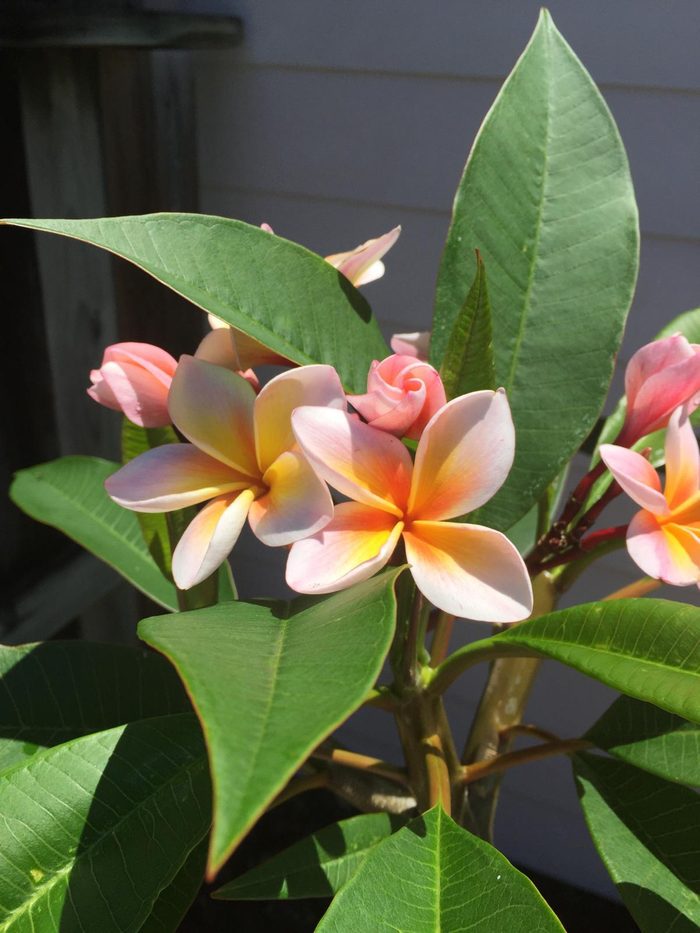
As with most tropical plants, plumeria is not cold-tolerant. In fact, it can be damaged when the temperatures fall into the 40s. (Here’s how to find the first and last frost dates). So if you grow it in any area below zone 10, you will have to take precautions in the winter.
The easiest way to do this is to grow it in a pot, and bring it inside when cool weather arrives. If you’d like to plant it outdoors, you can dig it up in the fall and keep it indoors over the winter. This is when the plant is generally dormant anyway. The Plumeria Society of America has good tips for dealing with the winter in colder climates.
Check out the top 10 flashy flowering succulents to grow.
Watering Plumeria
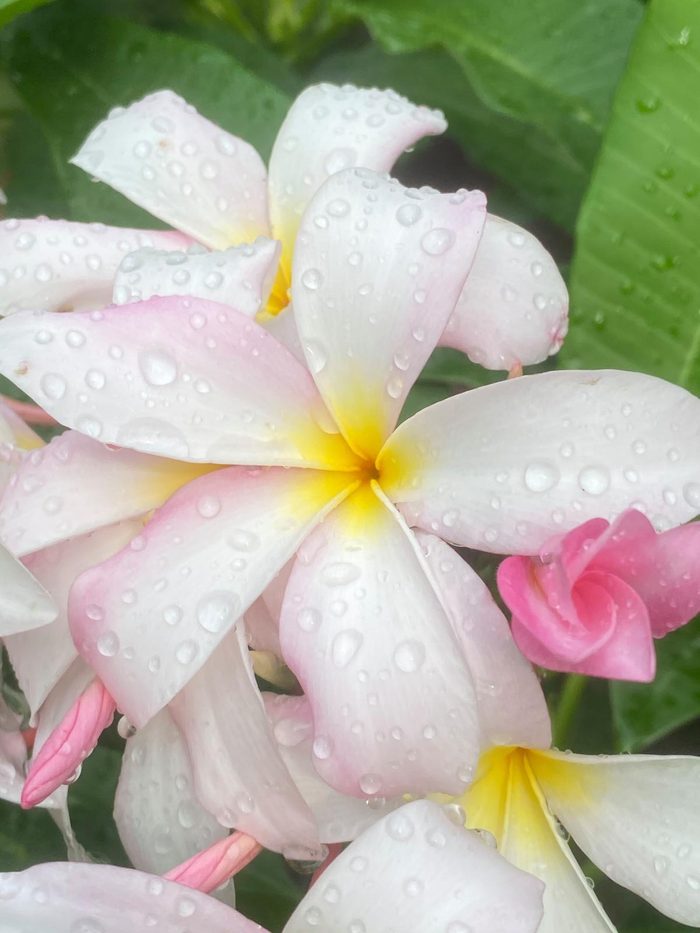
The wonderful thing about this gorgeous flowering plant is that it requires very little water, making it perfect for drought tolerant gardening. Plant it in well-draining soil (sand or sandy soil is ideal). Plumeria likes its soil to dry out between waterings, so expect to give it water once a week or so unless it receives rain.
Does Plumeria Attract Pollinators?
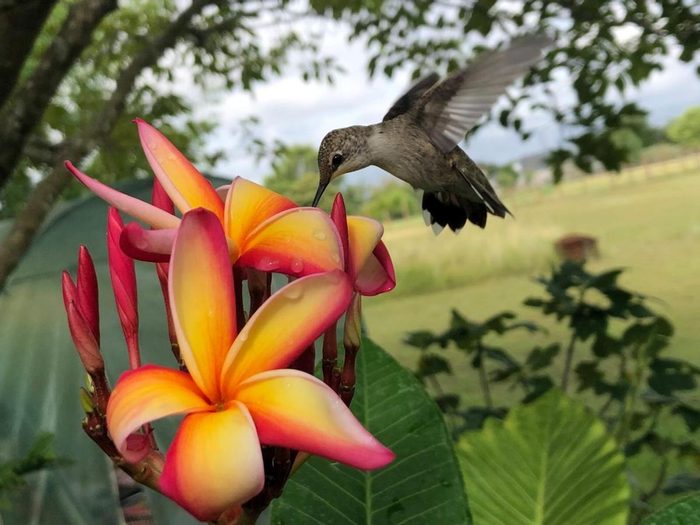
These fragrant flowers may attract bees and other pollinators. In the evening, watch for sphinx moths.
“I was in my backyard watering the plants. The plumeria bloom was beautiful, so I took a photo (above). I forgot about it by the time I went back in the house. It wasn’t until a week or so later that I actually looked at the photo and was shocked to see the visitor I had missed,” says reader Kay Smith.
About the Expert
Melinda Myers is the official gardening expert for Birds & Blooms. She is a TV/radio host, author and columnist who has written more than 20 gardening books. Melinda earned a master’s degree in horticulture from the University of Wisconsin-Madison.
Sources
- The Plumeria Society of America
- Missouri Botanical Garden
Why Trust Us
For nearly 30 years, Birds & Blooms, a Trusted Media Brand, has been inspiring readers to have a lifelong love of birding, gardening and nature. We are the #1 bird and garden magazine in North America and a trusted online resource for over 15 million outdoor enthusiasts annually. Our library of thousands of informative articles and how-tos has been written by trusted journalists and fact-checked by bird and garden experts for accuracy. In addition to our staff of experienced gardeners and bird-watchers, we hire individuals who have years of education and hands-on experience with birding, bird feeding, gardening, butterflies, bugs and more. Learn more about Birds & Blooms, our field editor program, and our submission guidelines.
On This Page
Yellow-Breasted Chat Identification
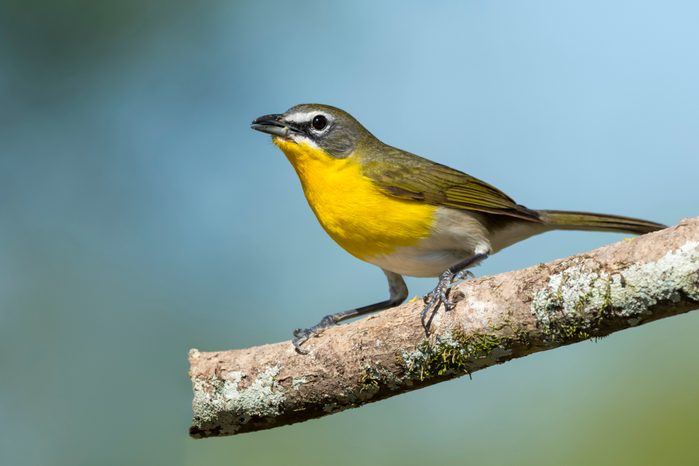
The bright yellow breast of this big-headed bird balances an olive-gray hue on its upper parts. White spectacles and mustache stripes accent its face, and a white lower belly and long tail feathers help in its identification. Males and females are similar in coloring.
Is a Yellow-Breasted Chat a Warbler?
Seven years ago, an exclusive nationwide committee of appointed senior ornithologists made a rare move—migrating the yellow-breasted chat from the warbler family into its own family based on genetic and physical characteristics. Long known scientifically as Icteria virens, the yellow-breasted chat is now alone in a new family, Icteriidae.
According to David Wiedenfeld, senior conservation scientist at the American Bird Conservancy, before that, “People thought they were really weird warblers. The vocalizations and some of their behaviors are different from any other warbler.” Importantly, they are also bigger than warblers.
David finds their flights fun to watch. “They have a characteristic flight display,” he says. “They fly 20 feet above the shrubs and trees and have this floppy butterfly kind of flight—they sort of flutter.” These birds make frequent calls during this flight display, another aspect that sets them apart from warblers.
Learn to identify 25 small yellow birds you might see.
Range and Migration
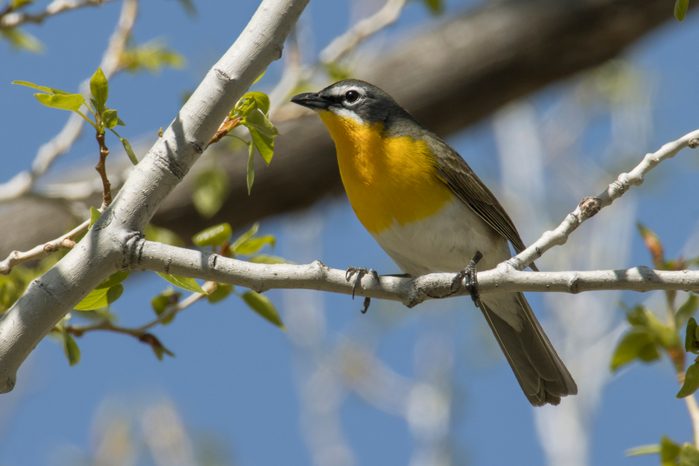
In the summer, chats are widespread in the southern U.S., north to the Great Lakes region and some areas of southwestern Canada. Most migrate south in the fall to spend the winter in Mexico or Central America.
Learn how to identify and attract a yellow-rumped warbler.
Population Numbers
The yellow-breasted chat’s numbers declined by about 32% between the mid-1960s and the late 2010s. But today, the bird is a low concern for conservation. Some states at the northern edge of the birds’ range, such as Connecticut, may consider them endangered, but farther south they are still common.
Have you ever seen a rare yellow cardinal?
Yellow-Breasted Chat Habitat
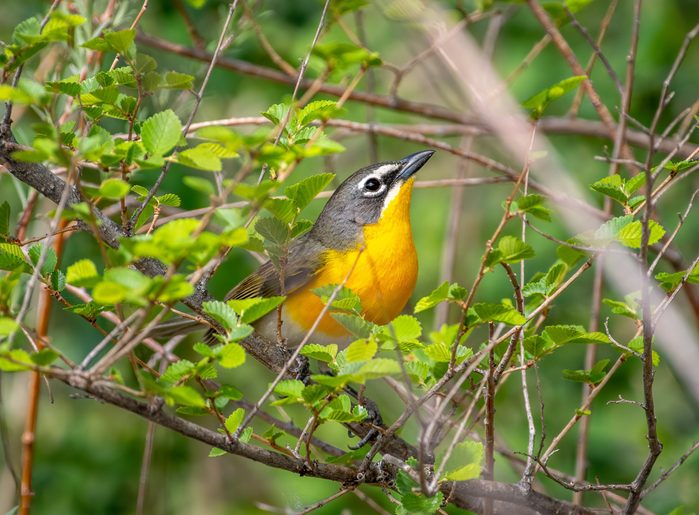
Unless your yard is full of low, thick brush, it’s hard to find this cleverly hidden bird in your backyard. Get permission to walk through old pine plantations and abandoned farm fields, or visit an accessible nature preserve.
Discover fascinating facts about warblers.
Nesting Behavior
According to the Cornell Lab of Ornithology, most males have one mate during breeding season. However, some have two, and studies have shown that females also occasionally mate outside of their otherwise monogamous partnerships. Males also display territorial flights and fights, which include grappling feet, loud thumps and audible wingbeats.
These birds make cute cup nests up to 3.5 inches across and 2.5 inches tall. They reuse abandoned nest sites, but still rebuild. The structure consists of grass, leaves, weed stems, wiry plant stems, pine needles and roots, even hair.
Look and listen for common yellowthroats in spring.
Diet: What Do Yellow-Breasted Chats Eat?
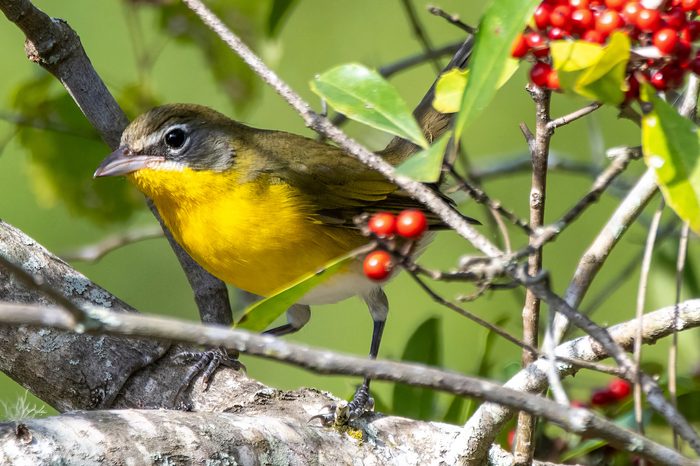
Chats are berry-loving birds. Find them in strawberry, blueberry, blackberry, raspberry or elderberry bushes, or near wild grapes. They also indulge in insects such as bugs, ants, bees, mayflies, cicadas, moths, caterpillars and beetles.
Song and Calls
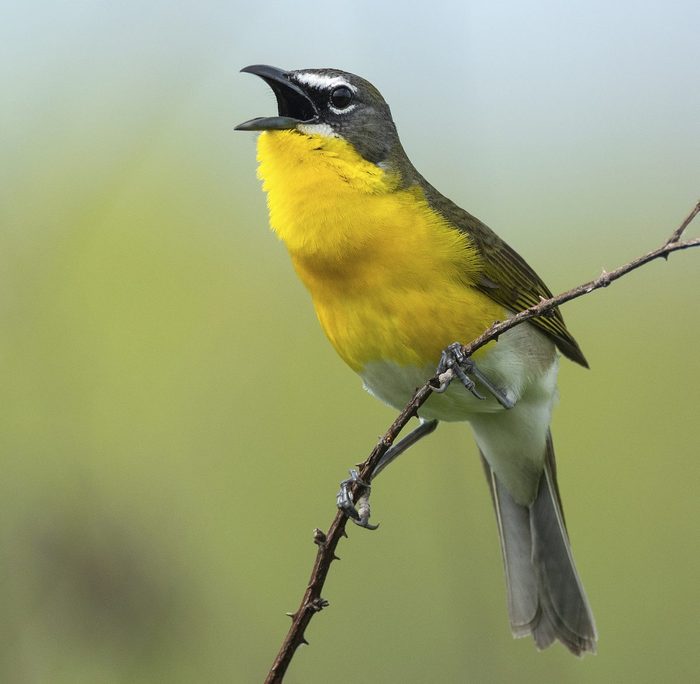
Chats have unmistakable cackles, clucks, whistles and hoots. The American Bird Conservancy quotes ornithologist Arthur Cleveland Bent, who observed “a medley of strange sounds”—catcalls, whistles and various bird notes—“betray the presence of this furtive and elusive clown among birds.”
Bird sounds courtesy of the Cornell Lab of Ornithology
Meet the vireo bird family: sweet summer singers.
About the Expert
David Wiedenfeld is a senior conservation scientist at the American Bird Conservancy. Earning a PhD from Florida State University, his scientific work has focused on prairie-chickens, parasites, and invasive species.
Sources
- Interview: David A. Wiedenfeld
- American Bird Conservancy
- National Audubon Society
- Department of Energy & Environmental Protection – State of Connecticut
- All About Birds
On springtime or early summer walks through the woods, you might find yourself surrounded by purple flowers and think, “Wow, look at all that lovely phlox!” But do a double take, because you might be seeing a troublesome phlox look-alike. Unfortunately, the object of your admiration could be an invasive species: dame’s rocket.
While dame’s rocket and phlox flowers look incredibly similar, you can learn tips and tricks to tell them apart. By learning the difference, you can make sure that what you’re seeing really is phlox—and that you’re not letting an invasive flower take control of your yard. Here’s what you need to know about dame’s rocket vs phlox.
On This Page
Identifying Dame’s Rocket
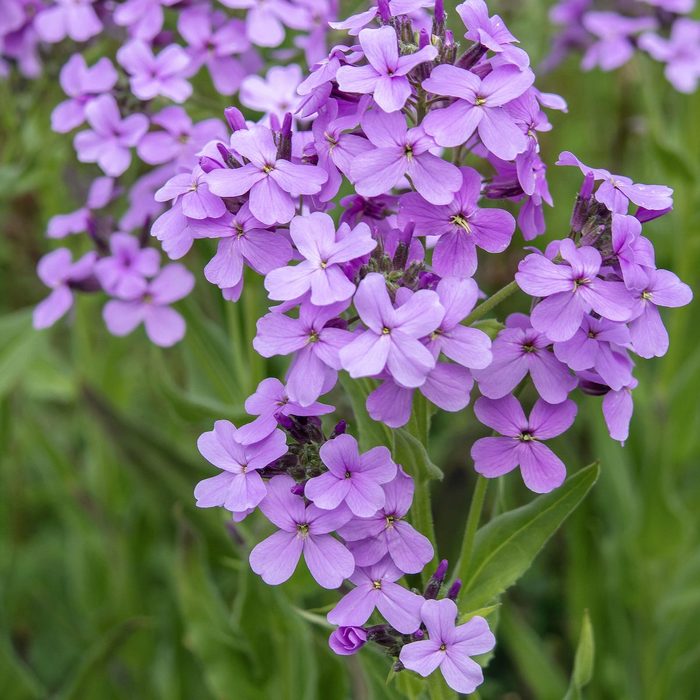
- Botanic name: Hesperis matronalis
- Zones: 3 to 9
To identify dame’s rocket (Hesperis matronalis), look for four-petaled pink, purple or white clustered flowers. Its leaves grow in lance shapes, and orient themselves singly on alternating sides of the stem. Those leaves are smooth. Growing in Zones 3 to 9, it typically reaches heights of 3 to 4 feet tall.
Although dame’s rocket seeds can be found in some “native” wildflower mixes, it is an introduced plant that is considered invasive in several states. Gardeners should read the contents of seed mixes before purchasing to avoid buying those that contain dame’s rocket.
To control its spread, remove dame’s rocket before it seeds. This plant is a biennial that will have only foliage the first year, and then will flower and seed the second year.
Wildflower identification 101: here’s how to get started.
Identifying Phlox
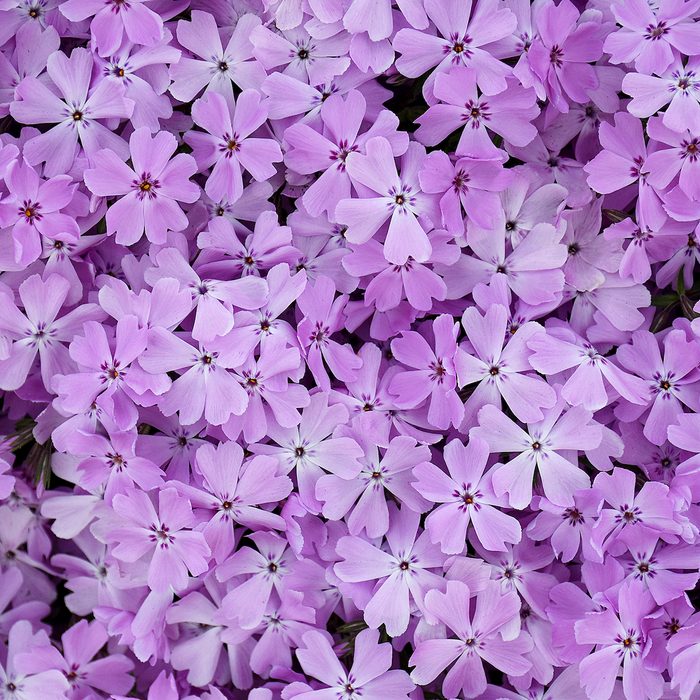
- Botanic name: Phlox spp.
- Zones: 3 or 4 to 9, depending on variety
To identify phlox (Phlox spp.), look for tight bunches of five-petaled flowers that come in almost every color. Some varieties have hairy leaves, while others are smooth. Those lance-shaped leaves grow opposite each other in pairs on the stem. Phlox grows in Zone 3 or Zone 4 to 9, depending on the specific variety. Plant heights can vary, with a range of 6 inches up to 4 feet.
For gardeners who want to get the most out of their phlox, consider consistent deadheading to encourage more blooms.
Phlox vs Dame’s Rocket: Key Differences
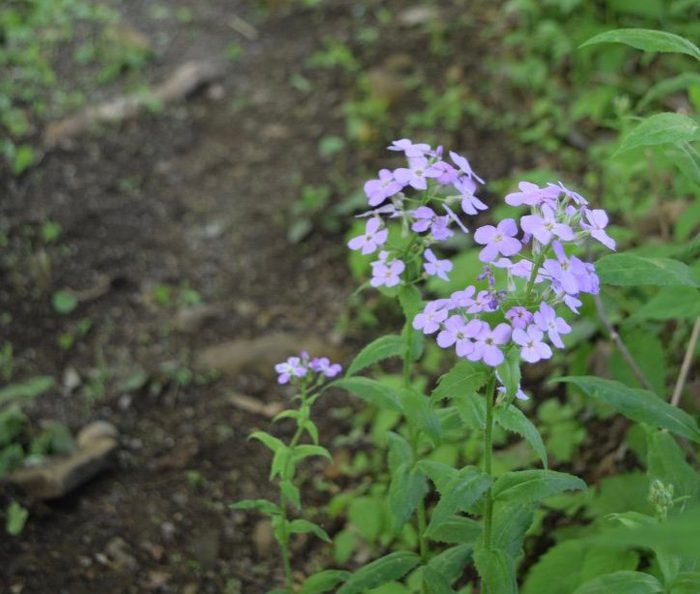
While these flowers have many similarities, it’s possible to them apart from each other at a glance.
One key difference? The number of petals on the flowers. Dame’s rocket has four flower petals, while phlox has five. In addition, if your plant has hairy leaves, there’s a good chance it’s phlox—dame’s rocket leaves are smooth.
If you’re dealing with dame’s rocket, learn how to remove invasive plant species for good.
Sources
- The Ohio State University
- South Dakota State University Extension
- Spring Hill Nursery
- University of Wisconsin Extension
- USDA Forest Service
- Proven Winners
Why Trust Us
For nearly 30 years, Birds & Blooms, a Trusted Media Brand, has been inspiring readers to have a lifelong love of birding, gardening and nature. We are the #1 bird and garden magazine in North America and a trusted online resource for over 15 million outdoor enthusiasts annually. Our library of thousands of informative articles and how-tos has been written by trusted journalists and fact-checked by bird and garden experts for accuracy. In addition to our staff of experienced gardeners and bird-watchers, we hire individuals who have years of education and hands-on experience with birding, bird feeding, gardening, butterflies, bugs and more. Learn more about Birds & Blooms, our field editor program, and our submission guidelines.
On This Page
What Is No Mow May?
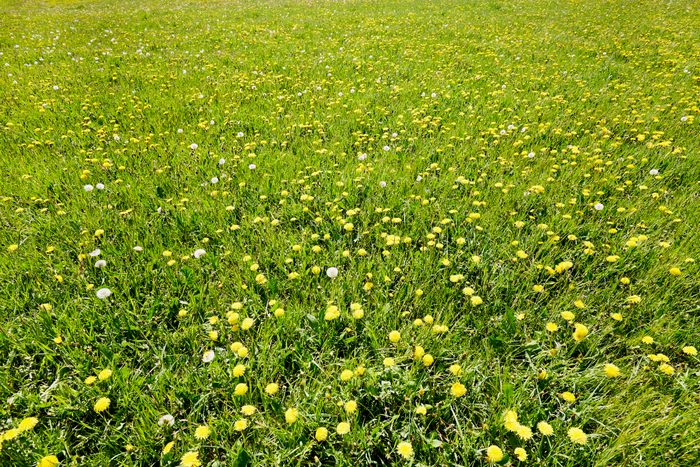
You’ve probably heard about No Mow May on social media or seen yard signs signifying participation and might want to give it a go. A growing trend on the garden and landscaping scene, it encourages delaying the first mow of the season to temporarily create a more biodiverse and hospitable habitat for pollinators awakening after winter—bees in particular.
Despite its admirable goal and seemingly simple execution, No Mow May might not be the best approach for everyone. Before foregoing the first mow, consider the following factors and some less controversial options.
Learn how to grow a pollinator garden.
Pros and Cons of No Mow May
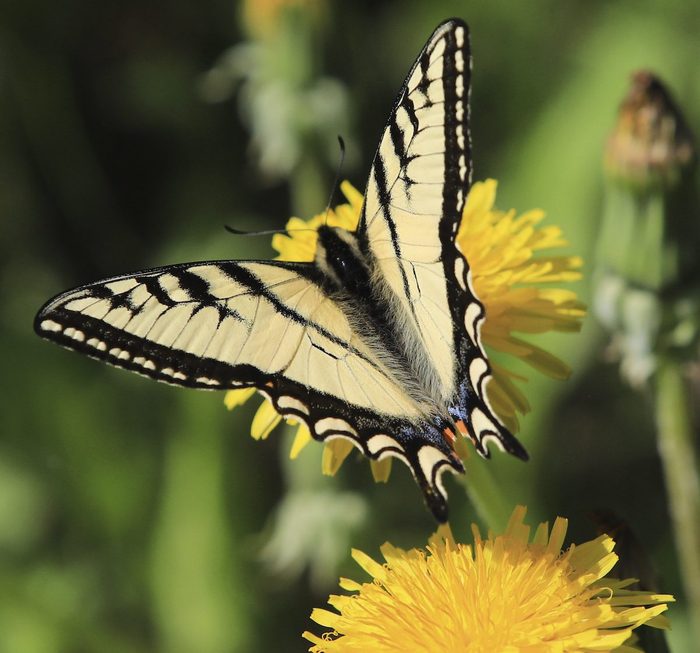
One advantage of this viral movement has been increased recognition of certain insects and their needs. “No Mow May has helped with awareness, to the point that some people now think National Pollinator Month is May and not June due to the public attention it has received,” says Birds & Blooms horticulture expert Melinda Myers.
And since it’s as easy as leaving your mower in storage for an extra month, it’s a low-commitment entry into the world of caring for pollinators. But it does have some downsides.
The pollinators that revel in your lush, unmowed lawn will likely return later, only to find a harsh surprise once their food sources have been sheared away. Or worse yet, bugs and critters who make their homes in uncut lawns may not survive a big chop at the end.
Then there’s the unkempt look. Some people want to help but prefer a well-maintained green space. Fortunately, other pollinator-friendly practices could help avoid these outcomes and better fit your style.
Follow these tips for growing a healthy lawn.
Do Some Research Before You Participate
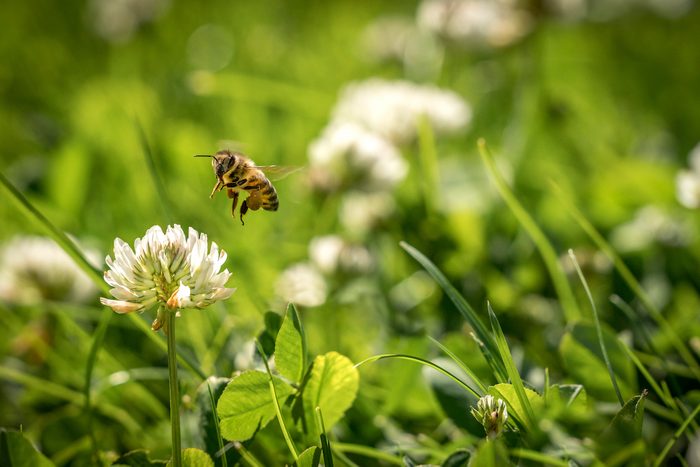
If you do plan to pause mowing, there are some important factors to investigate beforehand. The first is timing. No Mow May started in the United Kingdom, so even though it’s a catchy slogan, May might not be the best month for every region. The objective is to allow growth of flowering pollen sources, such as dandelion and clover. You’ll want to avoid mowing when they are in peak bloom.
If your lawn is treated for weeds, hold off on that too. “I have heard from lawn care companies that some customers who have their lawns treated regularly participated in No Mow, only to realize the treatments had already eradicated the pollinator plants,” Melinda says.
Furthermore, local ordinances and homeowners association rules vary, so determine what is allowed in your area before proceeding. If your city has a limit on grass height, try talking to the city council about exemptions. Encourage them to consider the merits.
Go lawn free: plant a prairie garden.
Share the Message With No Mow May Signs
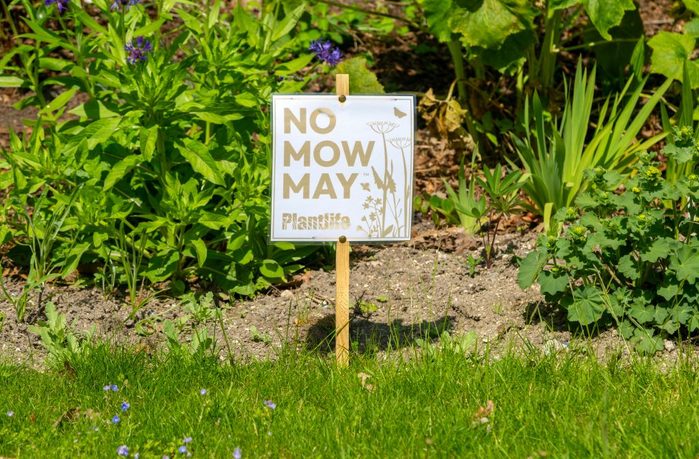
If your area supports the movement, see if they offer yard signs to help educate and engage your neighbors. A sign could also quell any disapproval of the less-than-tidy look!
Finally, keep in mind that it could be difficult and detrimental to tackle the immense growth at the end of the month. Lower the height of your grass slowly over several mows. This avoids sending it into shock and gives pollinators a chance to realize it’s being cut back.
Here’s what you need to know about native plants.
No Mow May Alternatives Abound
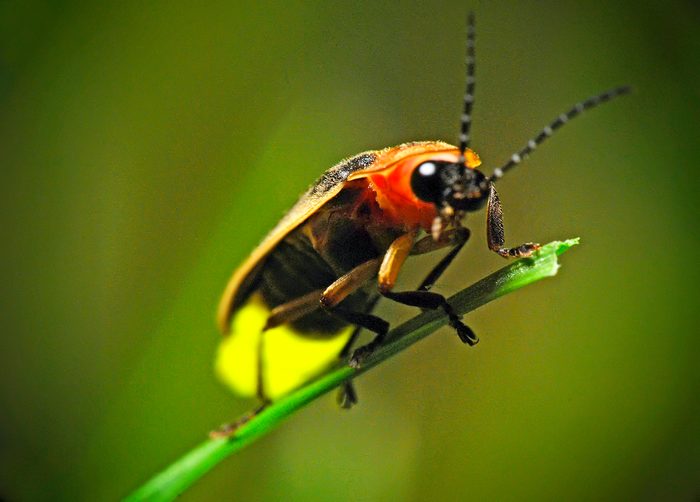
If you want to try a more intentional or long-term tactic, there are options for every level of commitment. Ease into it by decreasing your mowing frequency with a “Less Mow May.” You can also try reducing the use of chemicals and pesticides harmful to bees and their food sources.
Try pocket planting, which, as the name implies, is the practice of creating smaller areas with specific vegetation. This approach also works well in yards with limited space and municipal restrictions.
If you have the room and freedom and are ready to put in more effort, consider meadowscaping. This essentially rewilds your urban yard into an ecologically beneficial meadow. Once established, it can be very low maintenance.
Whether you nix mowing or take another pollinator-friendly path, discussing details with your local extension office is always a good first step. No matter the size or commitment, any amount of space or time you can offer pollinators will help.
About the Expert
Melinda Myers is the official garden expert for Birds & Blooms. She is a TV/radio host, author and columnist who has written more than 20 gardening books. Melinda earned a master’s degree in horticulture from the University of Wisconsin-Madison.
Sources
- National Garden Bureau
- Minnesota Public Radio News
- The Ohio State University
- American Meadows
- Better Homes & Gardens
- Blue Thumb
Why Trust Us
For nearly 30 years, Birds & Blooms, a Trusted Media Brand, has been inspiring readers to have a lifelong love of birding, gardening and nature. We are the #1 bird and garden magazine in North America and a trusted online resource for over 15 million outdoor enthusiasts annually. Our library of thousands of informative articles and how-tos has been written by trusted journalists and fact-checked by bird and garden experts for accuracy. In addition to our staff of experienced gardeners and bird-watchers, we hire individuals who have years of education and hands-on experience with birding, bird feeding, gardening, butterflies, bugs and more. Learn more about Birds & Blooms, our field editor program, and our submission guidelines.